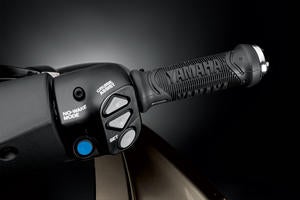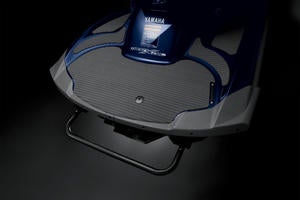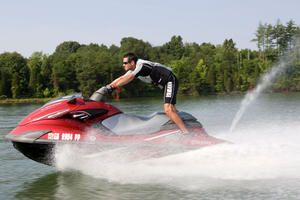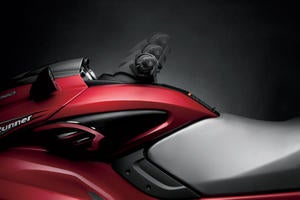Tuesday, June 22, 2010
YAMAHA OUTBOARD FREE GIFTS
Wednesday, June 16, 2010
YAMALUBE OUTBOARD MOTOR 2 STROKE OIL
1 Liter Yamalube Outboard can be mixed with 50 Liters Gasoline or 30 Liters Kerosene.
4 Liters Yamalube Outboard can be mixed with 200 Liters Gasoline or 120 Liters Kerosene.
20 Liters Yamalube Outboard can be mixed with 1 Ton Gasoline or 600 Liters Kerosene
YAMALUBE OUTBOARD MOTOR 2 STROKE OIL
 YAMALUBE OUTBOARD MOTOR 2 STROKE OIL is now available in PAIL (20 Liters). It is more economical, easy to carry and mix. 20 Liter (1 Pail) of Yamalube Outboard Oil can be mixed with 1 TON Gasoline. It is not only economical, but also maintain your engine to keep running smooth.
YAMALUBE OUTBOARD MOTOR 2 STROKE OIL is now available in PAIL (20 Liters). It is more economical, easy to carry and mix. 20 Liter (1 Pail) of Yamalube Outboard Oil can be mixed with 1 TON Gasoline. It is not only economical, but also maintain your engine to keep running smooth. Wednesday, June 9, 2010
Yamaha Outboard Stock Status
Garmin GPS 76CSx
 The GPSMAP 76CSx is is a high quality unit, built very rugged to ensure its compliance to the IPX7 standard, which among other things means that it is waterproof. Looks and feels good, and acquires quickly. The display is somewhat too small to take advantage of installed maps. This Garmin GPS is considered as dual purpose GPS, can be used on land and sea.
The GPSMAP 76CSx is is a high quality unit, built very rugged to ensure its compliance to the IPX7 standard, which among other things means that it is waterproof. Looks and feels good, and acquires quickly. The display is somewhat too small to take advantage of installed maps. This Garmin GPS is considered as dual purpose GPS, can be used on land and sea.Tested hardware and software
The test was done using a Garmin GPSMAP 76CSx bought off the shelf, with an Atlantic/European basemap. To get decent map coverage the Mapsource City Navigator Europe maps were added. In order to test its usefulness in a car, a car kit was used.
The GPSMAP 76CSx has undergone a burn-in test, in which it was operating 16 hours a day. It has been exposed to and operated in heavy rain and cold as far North as The North Cape in Norway.
It has a color screen and through the use of memory cards the ability to increase the map space to whatever capacity micro-SD/transflash cards come in. It is necessary to use a 4Gb card for all the City Navigator Europe version 9 maps, and it fits on the 4Gb card together with the necessary route indexing data needed for navigation. Be advised that loading all of Europe onto the 4Gb memory card takes several hours. The GPSMAP 76CSx has a maximum map set size limit of 1024, but it is currently not an issue, as all of Europe is made up of a total of 600 maps. It needs 2 AA size batteries.
The ability of the SIRF III chip in the GPSMAP 76CSx to find and use available GPS satellites is impressive. It seems better at picking up the satellite radio signals than previous Garmin units.
The GPSMAP 76CSx is rugged. It is obviously built to be able to handle nature, and not just nature at its best.
The GPSMAP 76CSx conforms to the IPX7 standard, which means that it can be held at 1 meter water depth for 30 minutes without problems.
The GPSMAP 76CSx swims. If dropped in water it doesn't sink.
The use of micro-SD memory cards makes it very easy to upgrade to a higher map capacity. The unit is currently being tested using a 4Gb memory card, and the increased memory size doesn't seem to make the unit slower.
There is not much maintenance of the unit - a damp cloth will usually do the trick.
The built-in USB 2.0 interface makes map updating much faster than you normally see in NMEA-compliant GPS receivers. This does not mean that you won't have to wait - loading a 512Mb memory card with maps can take an hour.
Garmin offers a pc webupdater program which checks for firmware updates to the unit as well as the SIRF chip when the Garmin is connected to the pc, and the pc is connected to the Internet. Updates fix issues with the unit so it's important to get the new upgrades as they come.
The GPSMAP 76CSx has a setup option to distinguish between the use of Alkaline batteries or NiMH rechargeable accumulators. NiMH accumulators are routinely used in this test and are recommended to cut operating costs.
The Garmin GPSMAP 76CSx is a high quality GPS receiver. It gives you a location quickly after power on, and is rugged. It is also going longer on a pair of batteries than you normally see in handheld units. The screen is large enough for map reading. The use of micro-SD/transflash memory cards for maps gives it an even better map capacity. It doesn't seem to be slower with a 4Gb card with the complete European maps and navigational indexes loaded than it is with the supplied 128Mb card.
Swan air Compressor
Monday, June 7, 2010
Yamalube Outboard Comparison
Thursday, June 3, 2010
Yamaha Waverunner FX SHO

(CLICK ON THE PICTURE TO ZOOM++)
Cool Tech
It was Yamaha that introduced us to electronic throttle two seasons back, and the features that it makes possible. Cruise control is probably the biggest draw. Yamaha’s Cruise Assist enables the driver to lock in any speed with the push of a button, and then simply squeeze the throttle to maintain it. Speed doesn’t fluctuate, your trigger finger doesn’t grow weary on extended rides, and tasks like towing become far more enjoyable for the parties at both ends of the towrope.
Release the throttle and the system disengages, returning control to the driver. Fine-tuning the speed is a matter of bumping up/down arrows on the handlebar; you can increase or decrease speed roughly five miles an hour up and down from your set cruising speed.
A twist on the cruise-control theme is No Wake Mode. This feature allowed me to push a button in those long no-wake zones, and then simply steer as the boat settles in at a nice 5 mph cruise. No pressure on the throttle is required. It’s a nice convenience, especially if you live with no-wake zones on a regular basis.
A further techno-infusion can be found in Yamaha’s hull makeup. By using nanotechnology — tinkering with matter on a molecular scale — the manufacturer was able to noticeably lighten its hull, while actually gaining strength. Sheet Molding Compound (SMC) is still the material of choice, but a different filler material in the mix allowed engineers to use less filler, and create a different kind of bond between the particles. The end result is a light, strong material that shaves about 25-percent of the weight off the previous hull.
Big Displacement
That weight advantage is fully exploited by the largest displacement engine in the industry, a 1.8-liter, inline four cylinder that employs a supercharger and intercooler to pack an explosive punch out of the hole. I edged over 67 mph in straight-line drag runs, and noted a 0-30mph acceleration time just beyond the 2.0-second mark.
 |
Handling is impressive, but as in previous years the boat’s personality takes a short time to get used to
Rough-water tracking is typical Yamaha, with an exacting presence that simply mows its way over the waves without any quirks. The FX SHO is predictable and solid, maybe throwing a jar or two the driver’s way when really pounding over the waves, but never proving unpredictable. Cornering ability is top notch, but be prepared for a small quirk. It feels almost like a slight roll along the boat’s lengthwise axis, as the boat hooks up aggressively, then seems to briefly release. Control is never affected; it’s simply a slight rocking that takes a few passes to get used to. Pre-NanoXCel models didn’t seem to exhibit the same tendency, so I almost wonder if it’s just the lighter weight hull now sitting higher atop the water.
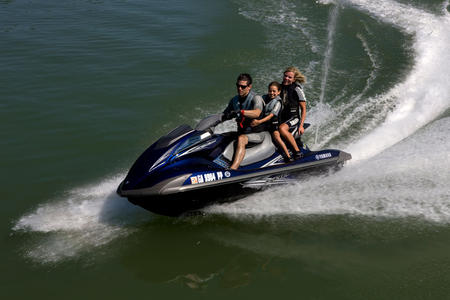 |
In The Details
Yamaha continues to use a manual trim system to drop the jet nozzle, allowing the pilot to drop the bow in the corners or trim up for speed. It’s got pluses and minuses. The plus is that it’s a manual system that doesn’t require the driver keep track of a gauge. The minus is that a manual trim can be difficult to move when so much thrust is moving through the pump at high speeds.
Yamaha continues to feature a starboard-located reverse handle. Personally I think even Yamaha execs would rather have the handle on the left hand side of the cowl, but it remains on the right, where those legal types say it prevents a driver from employing reverse while also using the throttle. Like so many other boats that use this setup, we say let adults be responsible for their safety, and make it easier to maneuver around the dock by allowing the control of both throttle and reverse positioning simultaneously.
Nice extras include a flip-down boarding step for deep water boarding, a car-like remote that can disable the craft for security or be used to put it into a novice-friendly, or gas-saving low RPM mode, and adjustable handlebar tilt to dial in the ergonomics to fit the rider. Storage is divided between a front bow tub, deep glovebox with cupholders, and a watertight, canister-like compartment on the steering console.
I continue to applaud Yamaha for designing its engines to run to their full potential on 87-octane pump gas.
Let’s Cruise
So what have we overlooked? What makes the boat a cruiser by definition — the plush, bolstered touring seat that offers tremendous lower-back support and allows drivers to kick back in comfort on long rides. Yamaha notes the boat has a three-point contact system for drivers. The seat, foot chocks, and handlebars all combine to increase the driver’s comfort. I know a few hardcore cruisers and they love the laid-back style. The cruiser package also means you get a fuel-flow meter to help plan fuel stops on long trips.
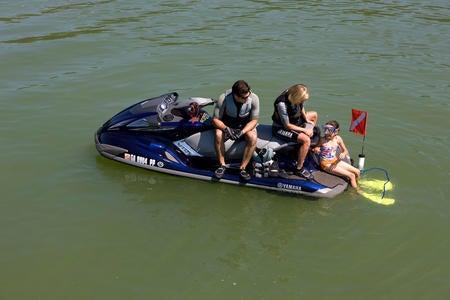 |
The FX SHO is also offered in a non-cruiser model, without the seat and fuel-flow package. It’s essentially the same, save for different color packages. The Cruiser is featured in either a dark blue or platinum metallic; the sportier-minded FX SHO is offered in black or red metallics.
Yamaha Waverunner SuperJet

When Yamaha introduced its new range of personal watercraft last summer, the company made a big deal about its new supercharged runabout (the FX SHO); however, it seemed that nobody had noticed that the SuperJet was given a major overhaul. While the engine remained the same, the SuperJet was equipped with a brand new hull that was originally designed and developed by Rius Racing.
Hull Characteristics
Rius Racing originally developed the new hull for the European GP Ski class. The hull features specially designed built-in front sponsons that increased the width of the front section. Additionally, the stern is narrower and the strakes are deeper. The pump was moved backwards 50mm and the ride plate length was increased in order to create a longer waterline length.
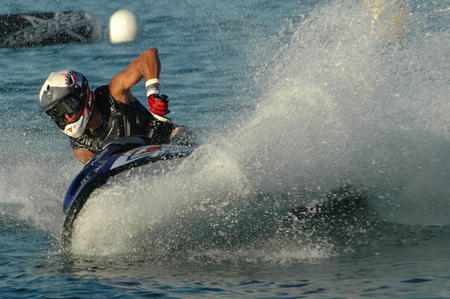 |
Additionally, Yamaha engineers enhanced rider ergonomics by putting in a shorter handle pole, which provides a lean-forward posture, ideal for racing use. The handle pole was also equipped with a harder spring that ensures less rider fatigue. The Hyper-Flow jet pump accommodates a new stainless steel impeller and an adjustable steering nozzle.
Race-Course Oriented
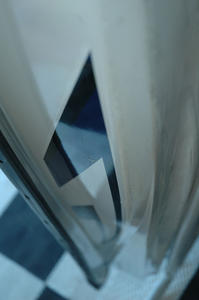 | 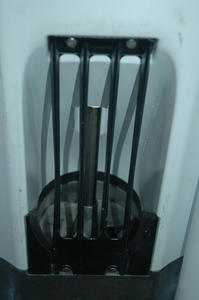 |
Having ridden Rius’s carbon hull power valve engine SuperJet only four days prior to testing the new stock SuperJet gave me an idea of what I could expect to feel when I climbed aboard the Yamaha. The actual test was carried out on Lake Havasu in Arizona by using part of the official race course. World famous freestyle rider, Canadian Rick Roy, also demanded to ride the SuperJet, a will that Yamaha WaveRunner product manager Scott Watkins fulfilled since he has a great respect for the pioneer of the new Freestyle generation.
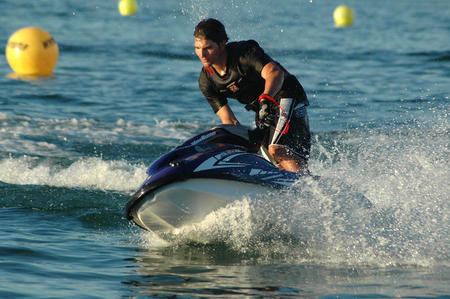 |
What surprised me most on the new, improved SuperJet was how it steered round the buoy. The 2009 SuperJet turns sharply and aggressively. The hull design enabled me to grade it in the curve rather than keep it flat on the water surface. The harder I was pushing it round the buoy the sharper it was turning. It was a unique feeling that no other SuperJet had given me in the past except the Rius Racing GP Ski.
Undoubtedly the team had done a great job. The steering was precise, accurate and less forgiving in comparison to its predecessor. The lightweight feel of the Yamaha has remained unchanged and the new riding position provids a better overall mass distribution. The new hull gave me a better feeling and enhanced information of how the hull was gripping, so when I was pushing it to its limits, it responded well by providing predictable handling. Also noticeable was the fact that there was less nose hopping at top speed in comparison to the previous model.
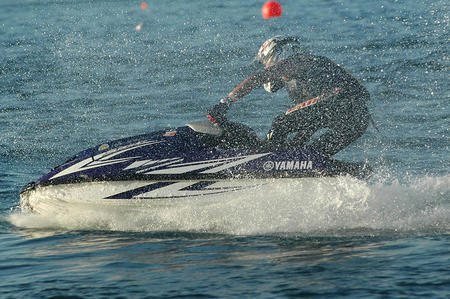 |
Having ridden Rius’s SuperJet just four days prior to riding Yamaha’s factory model, another thing that really stood out was the stock engine’s performance. There is no doubt that the Yamaha OEM engine needs some updating. It has been in the market successfully for 10 years, but the market demands have changed. Though it still provides good bottom end acceleration and linear power delivery from midrange, I believe that Yamaha could have improved the overall package with off the shelve parts. On the other hand, I was already informed that the Japanese department did not want to raise the overall cost of the particular model since the market demand is substantially lower in the stand-up class. For the time being the aftermarket will have to be relied upon for engine improvements.
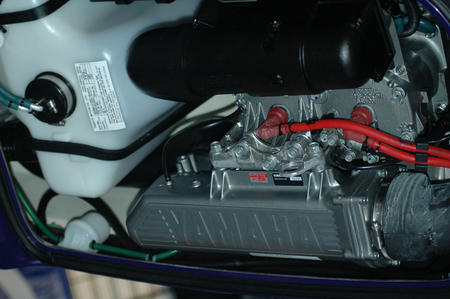 |
Most WaveRunner fans were expecting Yamaha to launch a new 4-stroke stand up, though the Japanese firm kept the same recipe under the hood of the Super Jet. Scott Watkins assured me that Yamaha has been extensively testing 4-stroke packages for the SuperJet. Yamaha has tried single cylinder, two cylinder and even four cylinder options. Water is bound to get into the engine compartment no how much you try to avoid it and that gives Yamaha some concern about the 4-stroke project.
In the next few years 4-stroke Skis will rise to the market from the Japanese constructors, though they will make sure that these Skis have superb performance, excellent reliability.
Yamaha Waverunner FZR

Championship Pedigree
Yamaha has a long track record with performance two-seaters. The GP (later GPR) series was a runaway favorite for years, sporting an aggressive handling personality and rocket-ship acceleration that thrilled both racer and wannabe alike. The death of the two-stroke ultimately sent that craft off into the sunset, but its spirit unquestionably lives on in the FZR.
 |
The FZR is almost identical in size to the FX line, but the FZ series (yes, it’s got a fraternal twin, the three-passenger FZS) is actually shorter in running surface, and features lifting strakes that run virtually the full length of the hull to improve top speed. It also features a GP-reminiscent dihedral keel shape, along with its own unique softly rounded chines. Moving away from a sharp chine edge allows this boat to roll more easily into the turns with an inside lean, giving the boat a quick, edgy personality.
A larger pump design than the FX funnels more water into the pump, enhancing acceleration. Providing that acceleration is the same 1.8-liter supercharged/intercooled engine found in the FX SHO, an 87-octane friendly combination that here pushes a craft weighing just over 800 pounds. In that way, the FZR is again like the GPs of old – it has a very favorable power-to-weight ratio. While the company no longer publishes horsepower numbers, it’s pegged at over 200 hp, but runs with machines rated much higher. Depending on conditions, I’ve reached anywhere from 66-68 mph on the top end, and rocketed to 30 mph in as little as 1.9 seconds.
Throttle response is delightfully crisp. The FZR uses Yamaha’s electronic throttle technology, meaning you’re no longer pulling a wire to send your intentions to the throttle body. Pin the lever and the craft leaps forward with authority. That hull shaves some of its weight through nanotechnology. Yamaha engineers introduced a new form of SMC a few years back, and it’s lighter, yet stronger, than the company’s former lay-up.
New Attitude
The craft’s personality differs depending on where you’ve set the aforementioned steering column. Most of the early hype seemed to center on the fully stretched out position, which locates the bars high enough that most riders can comfortably stand and absorb some rough-water shock with their legs. Bending over awkwardly is now a thing of the past. Pull the lever and extend the bars upward and you’re comfortable standing for long periods of time. Mission accomplished.
I think the boat’s real thrill, however, is in the opposite position. As much as the bars can extend beyond the norm, they can also lower below the average. In this setting, the driver feels ultra-aggressive and close to the water, railing through corners like the pilot of a souped-up street bike. Especially in calm water, the hull holds tenaciously, resulting in a high-speed carvefest for those who appreciate pure handling. It’s also a classic Yamaha design, in that it rides stable and predictable through the rough stuff.
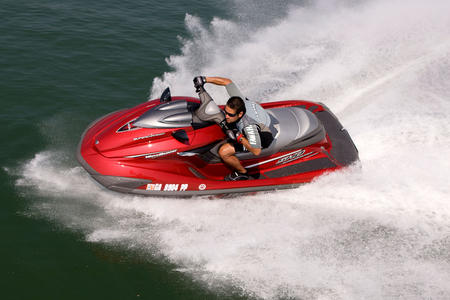 |
I only wish that the boat offered some form of electronic trim. Yamaha’s manual trim position has been around forever, and seems like a great idea as you don’t need to take your eyes off the water. Shifting on the fly, however, is not always realistic, as the force of water exiting the pump often fights your ability to force the nozzle downwards entering a turn.
Extra, Extra
Boats today need extras, and the FZR complies. A keyfob-style remote can be used to lock the craft for security. It also doubles as a speed-governing device for those times you want to turn the controls over to a newcomer or youngster, or save on fuel. There are also cup holders located in the glovebox, one element of the total 21.3-gallon storage capacity. The sloping back deck design doesn’t always make for easy reboarding (easy to get on, but often easy to slip back off as well) but it suits the craft. Reverse is tempered by the electronic throttle, meaning it won’t over-rev and lose traction.
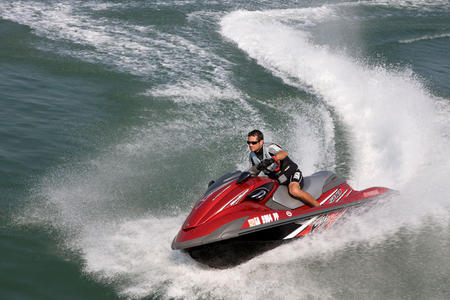 |
Thankfully, Yamaha resisted the temptation to juice up the dash display. Instead of high tech digital mania, you’ll find dual, red-trimmed analog gauges, just right in my opinion for this type of performance slant. Add in the red deck/black hull design, and you’ve got a craft that looks the part.
In that way, you can definitely judge this book by its cover.
Wednesday, June 2, 2010
Yamaha F250 4Stroke

Yamaha showcased its new 250hp four-stroke engine to a group of marine media in September. The engine rounds out a full range of four-strokes from 2.5-250hp, including the recently-released and extraordinarily fuel-efficient 50, 60, 80, and 100hp four-strokes designed for small to medium-sized trailerboats. The four-stroke range compliments Yamaha's ever-popular two-stroke range, which is renowned for reliability and ease of servicing, and also includes the high-pressure direct-injection V-Max series from 150-300hp.
Of interest to small-boat owners is a new tiller handle, which is available for small- to mid-sized trailerboats. The tiller arm allows the operator to set trolling speed using a simple dial, anywhere from 600-1000rpm, and comes with electric start, throttle tension, power trim and tilt and gearshift functions at your fingertips. Combined with the extra length and ergonomic design, the new tiller arm makes controlling larger outboards easier than ever before. And it can be retrofitted to recent-model Yamaha outboards for just a few hundred dollars.
TOP GUN
The big news on the day, however, was the big 250hp four-stroke. The F250A houses a 3.3lt V6 powerhead with 24 valve DOHC technology delivering 250hp at the propshaft. The engine is based on the same 3.3lt powerhead from the F225A but boasts new single-belt driven Variable Camshaft Timing and 24 valve DOHC engine technologies to produce more low- to mid-range torque, outstanding fuel efficiency and exceptionally low exhaust emission levels, Yamaha claims.
Mounted on three different boats, the effect of the variable valve timing on the F250 could be felt immediately, with immense torque and pick-up being generated in the upper end of the rev range between 4000-6000rpm. Variable Camshaft Timing both increases and decreases the camshaft timing according to the engine rpm to increase the intake and exhaust efficiency throughout the low to mid range rpm band.
RELIABLITY
For additional strength and durability, the F250A features lightweight forged pistons and a heat-treated crankshaft and connecting rods. Yamaha opted for a single-belt drive with less moving parts, multi-point fuel injection for optimum all-weather operation and a high-output 46amp alternator to power all your boat's electrical systems.
Clean and fuel efficient operation is achieved through a blow-by gas re-burning system which removes any unburned fuel and sends it back to the combustion chamber. Quiet operation is also delivered by the large intake silencer and the noise-suppressing labyrinth exhaust system. Such refined engineering reduces exhaust emissions to CARB three-star levels. At all speeds, normal conversation could be had at the helm on all the boats - it really is a very smooth, quiet engine.
COMPUTER-CONTROLLEDYamaha's sophisticated Electronic Control Module (ECM) is the driving intelligence behind the F250A. The electronically-controlled single throttle valve system - a first for Yamaha - enables precise control over the air intake, which is directed smoothly into each combustion chamber for greater power. The ECM receives input from nine sensors located around the engine and warns the operator of any impending problems. Should any sensors fail, Yamaha's Fail Safe System keeps the engine running. Concerns of engine temperature, amp output, and oil pressure should now be non existent, Yamaha says.
To make maintenance easier, a front-mounted freshwater flushing port offers convenient engine flushing without turning the key. Reliability and longevity is also enhanced with Yamaha's five-stage multiple coating over YDC-30 aluminium, more stainless steel componets, zinc sacrificial anodes, a super-tight cowling and the flushing system help to protect against corrosion.
PERFORMANCE
An engine each was mounted on a 7.4m plate aluminium AMM fishing boat, Cruise Craft's 685 Outsider and a Whittley 700 Sea Legend. The 250 had loads of power, particularly in the bottom and top end of the rpm range. It was also remarkably quiet for such a large engine.
The F250 pushed the big Cruise Craft out to 80kmh at 5900rpm, using 80lt/h of fuel. Backed off, a sea-keeping cruise of 42kmh was achieved at 3500 using just 26lt/h of fuel - excellent efficiency for blue-water long-hauling and of high importance considering rising petrol prices.
Yamaha 200HP 2Stroke

Proven Performance
These amazing motors are the building blocks upon which our enviable reputation has been built…
From our V6 200hp to our V4 115hp model these legendary Saltwater Series two strokes have always been a family favourite. Renowned for their reliablity, power and value, Yamaha’s range of large two strokes are proven performers.
Packed with the latest features such as micro computer controlled ignition and Precision Blend oil injection system, Yamaha’s Saltwater series guarantees optimum smooth running and excellent durability.
These engines are a great option if you’re looking for big horsepower and great value.
- Great power to weight ratios
- Punchy acceleration
- Loop charging boosts power and fuel efficiency
- Precision Blend oil injection system guarantees the optimum smooth running and excellent durability. It also eliminates the need for pre mixing two stroke fuel.
- Multi function gauges come standard giving the driver all the information needed such as speed, trim angle and other vital engine functions
Engine
| Engine Type | 2-Stroke, 90°-V6 |
|---|---|
| Displacement | 2596 cc |
| Bore x Stroke | 90 x 68 mm |
| Recommended Max RPM | 5000-5500 |
| Lubrication System | Oil injection |
| Fuel Management | Carb |
| Ignition | CDI |
| Starter System | Electric |
| Alternator Output | 12V - 25A with rectifier regulator |
| Operation Method | Remote control |
| Trim & Tilt Method | Power trim & tilt |
| Digital Guages | Standard |
| Gear Ratio | 1.86 : 1 |
| OEDA Emission Rating | 1 |
Dimensions
| Height |
|
|---|---|
| Weight |
|
Tuesday, June 1, 2010
Yamaha F350 4Stroke


It delivers everything implied in the 350hp/V8 description – oodles of torque and deep, gut-wrenching acceleration (a 45 per cent increase in thrust over a conventional 250hp four-stroke outboard). What’s missing is the V8 rumble: it's a remarkably quiet, smooth engine, free of any expected vibration. Boating journos glanced backwards on a number of occasions as we coasted to a stop – "whoops – the engine's just died."
It’s also equipped with a fascinating array of engineering innovations (it received the prestigious IBEX 2007 Award for Innovation late last year) that deliver performance, surprising fuel efficiency and the promise of hours of trouble-free running.
Apart from the space advantages in opting for an outboard on a large offshore boat (in place of the more conventional inboards with shafts or stern legs), there is also a substantial weight benefit – not only versus inboard engines, but also twin-rig outboards. Consider that the F350 weighs in at around 365kg – compared with the 440kg of twin Yamaha 150s (220kg each).




